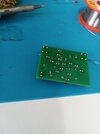Zestfully4
New Member
Should I replace it? Is it damaged, or will it work? Is it safe to test with the power source of 4.5V? I have a feeling something might go wrong if connected to power. But if I should test it, perhaps there's a way you can recommend for testing with multimeter?
I don't have a replacement at hand and don't have experience yet to determine whether a component is bad or not with visual, so please understand.

I don't have a replacement at hand and don't have experience yet to determine whether a component is bad or not with visual, so please understand.


